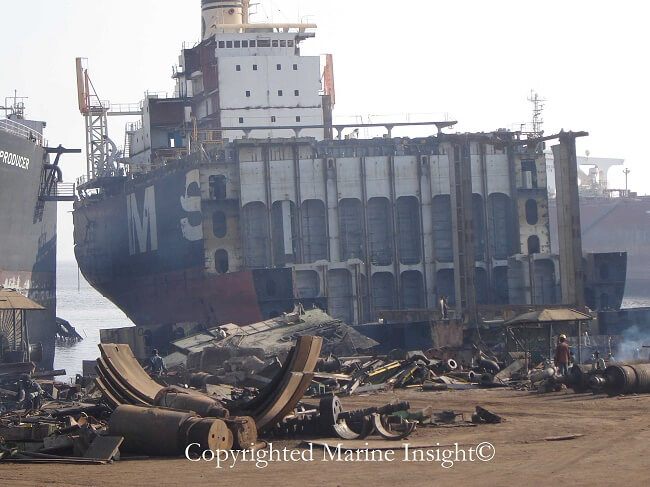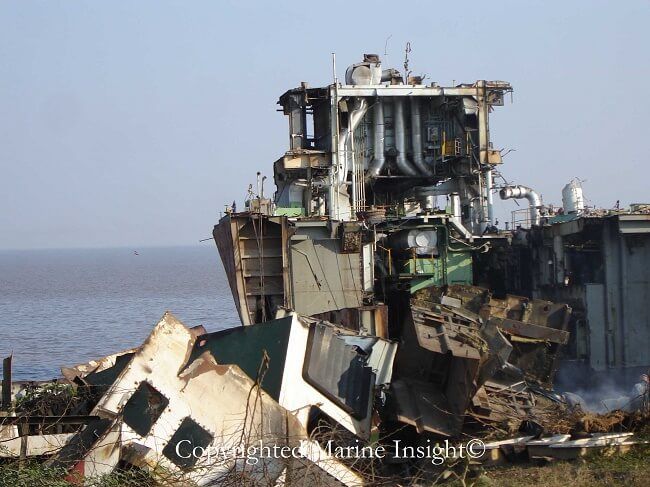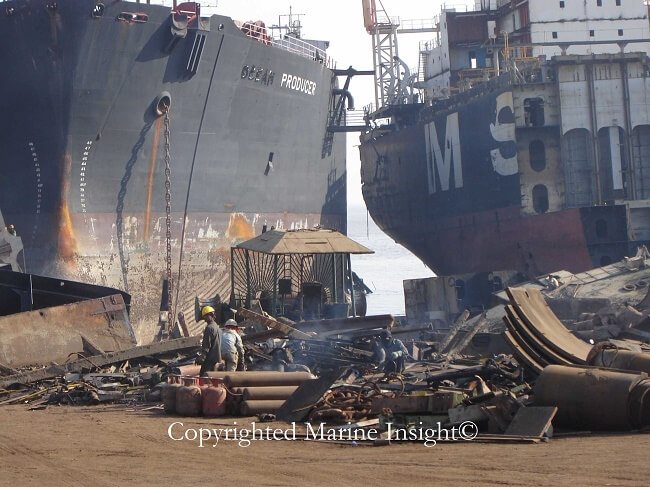

Ship dismantling, also popularly referred to as “ship recycling” is a process of breaking down a ship (also called ship breaking) when it completes its life tenure. As one of the ship disposal techniques, ship dismantling involves the retired ships to be stripped off their machinery, barring the value-adding materials which are rightfully reused for new ships or for other applications.
The steel scraps obtained after dismantling an old ship is liquefied and used again in building new vessels. The molten steel is renovated and proves useful even for many other industries. Moreover, all other parts such as wooden furniture, glass etc. are also reused for a variety of applications.
Ship dismantling is highly necessary as the maintenance expenses of a particular vessel keep soaring with time and it becomes really difficult to handle the same. Therefore, the shipowners seek the easy way out and hand over the old vessel for effective disposal, so that they can concentrate on dealing with other regular expenses like port charges, fuel charges, and also salaries of the crew members.


The primary and the most common way to dismantle a ship is by breaking it apart into several different parts before breaking them further. On some of the biggest ship breaking yards in the world such as Alang in India, the process of dismantling starts by beaching the ship on the shore. Several ship breaking contractors have their offices and yards along the coast of Alang, Gujarat.
The vessel on its final journey needs to float steadily and hit the beach of the shipping yard where it staggers and stops. Once on the shore, the engine is shut down and the anchor is dropped to make the ship steady. The ship breakers then start working after preparing a plan.
At the site, the laborers pull the vessel upon the beach, with the help of strong chains, cables, and machinery systems. This is one of the most dangerous tasks of the ship dismantling process. Sometimes chains might break during the process, leading to unfortunate accidents and great harm to the laborers.


Several regulations have to be followed for dismantling a ship. The Hong Kong International Convention for the Safety and Environmentally Sound Recycling of the Ships, 2009, was adopted to ensure that the ship breaking procedure do not pose any unnecessary risk to human health, safety and environment. However, at ship breaking yards in developing countries hardly any laws are properly followed, which has caused great danger to the human life and environment.
Also, before the dismantling process starts, the fuel tanks of the ships are completely drained to prevent any accidental explosions in the yard. Then the “scrappers” take over the particular vessel to explore it and locate useful items that may include flags, liquor, plumbing, electrical wiring, electronics, furniture, and machinery. All these items are reused or sold in the local market. Traders from different parts of the country visit Alang Ship Breaking Yard to buy scrap and reusable items at bargained price.
The real demolition of the ship begins after the initial scrapping process is over. The shipboard supervisor and other authorized personnel will then inspect the entire ship and decide the immediate course of action. Technically, there are no basic guidelines as such on how to break a ship. It is the intent observation and countless project experiences of the advisors that counts in the process rather than any bookish knowledge. However, strict safety guidelines need to be followed by everyone involved with the ship dismantling procedure.


As the actual dismantling starts, the ship breaking laborers are armed with a variety of torches, sheer elbow greases and sledgehammers to tear down the anatomy of the ship. The period of disassembling can vary anywhere from two weeks to even twelve months
Ship dismantling is regarded to be one of the most dangerous professions in the world as it involves a great amount of risks and hazards. Several guidelines and programs have been formed be tackled the consequences and control the oddities of this profession. It is definitely a Herculean task to break apart a sturdy ship as it had been built to be impregnable so as to withstand the harsh weather conditions and ocean storms and support countless tones of cargo.
Many toxic ships contain dangerous substances such as asbestos, petrochemicals byproducts, lead, mercury, Polychlorinated Biphenyls, radium, poisons and heavy metal machinery, which are extremely harmful to humans and environment. Moreover, the workers work with the least personal protective equipment and in really rough weather and temperature conditions.
The laborers are also extremely poor and desperate to earn some quick money. They are subjected to mortal perils every single day and the death toll in such ship breaking yards are rising in spite of all the precautionary measures.
Due to the large availability of cheap labors in poor nations such as Bangladesh, China, Pakistan and India, ship dismantling business is thriving in these regions. Around 85 percent of the world’s shipbreaking activities occur in these above named countries. The sites located in India are highly favorable as the shipyards offer high tidal ranges, 15-degree slopes and the coastlines are free of mud.
Disassembling of vessels comes at a huge price for it causes various environmental hazards. The non-ecofriendly dismantling techniques are a serious international concern and stringent regulations are implemented to prevent the disastrous consequences. Especially, the companies that engage in the beaching dismantling method, face stern opposition as beaching affects the ecosystem a lot. Interestingly, the ship disposal companies flourish in the third-world or developing nations, mainly because of the easy availability of cheap labor.
Other favorable conditions may include the slackened laws when it comes to environmental protection or labor health, and the ever-increasing demand for steel. This tragic lack of definite government rules leads to an inevitable bout of pollution in such countries and the rate at which the workers are injured just keeps on increasing.
The Basel Convention is a renowned name as it is majorly involved in tackling the ship disposal issues. The disposable vessels comprise of a vast range of hazardous substances, for instance PCB, asbestos and certain waste oil products. As a recent development, the Basel Convention has united with the International Maritime Organization (IMO) to ascertain dedicated observance of improved rules and regulations in order to prevent the environment from irreparable harm.
You may also like to read – Legal Issues And Arrest Of Scrap Ships Can Sour Deals For Indian Cash Buyers










We believe that knowledge is power, and we’re committed to empowering our readers with the information and resources they need to succeed in the merchant navy industry.
Whether you’re looking for advice on career planning, news and analysis, or just want to connect with other aspiring merchant navy applicants, The Marine Learners is the place to be.